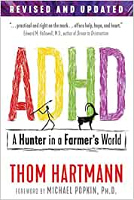
Image by Pexels
There must be no barriers to freedom of inquiry. There is no place for dogma in science. The scientist is free, and must be free to ask any question, to doubt any assertion, to seek for any evidence, to correct any errors. -- Robert Oppenheimer (Life, October 10, 1949)
New advances in anthropology and paleontology have answered one of the most vexing questions about the Hunter/Farmer theory: “Why is the leftover Hunter/ADHD gene only present in a minority of our population, and where have all the hunters gone?”
In popular literature, Riane Eisler, author of The Chalice and the Blade and Sacred Pleasures, has explored early cultures and shows the fundamental differences between what she calls “cooperator” and “dominator” cultures. (We in Western civilization are members of the latter.)
Similarly, Daniel Quinn, in his books Ishmael and The Story of B, writes about “Leavers” and “Takers” to describe a similar cultural division. About five thousand years ago, these cultural schisms set the stage for a mass extermination of hunter-gatherer peoples that continues to this day in remote parts of Africa, Asia, and the Americas.
From Hunter-Gatherers Diversity to Farmer Dominator Culture
A brilliant study published in the February 1994 issue of Discover magazine detailed the exact answer to the question of when and how this happened, and has since been corroborated by other researchers. Using an analysis of language patterns and DNA, researchers found that three thousand years ago, Africa was almost entirely populated by thousands of different (genetically and in language) tribes of hunter-gatherer peoples. Population density was low and, apparently, strife was minimal.
Then a group of Bantu-speaking agriculturists in the northwestern part of Africa were apparently infected with what University of California professor of Native American Studies Jack Forbes calls the “cultural mental illness” of Wétiko (a Native American term for the amoral and predatory behavior of the European invaders). Wétiko is the term that Forbes applied decades ago to describe what Eisler and Quinn today call “dominator” and “taker” cultural mass psychology.
In his penetrating and thought-provoking book Columbus and Other Cannibals, Professor Forbes points out how Wétiko, which he calls a “highly-contagious form of mental illness,” originated in Mesopotamia around five thousand years ago. From there, it spread across the fertile crescent and into Syria, eventually infecting northern Africa, Europe (via the Roman conquerors who carried Wétiko), Asia, and, with the arrival of Columbus, the Americas.
Wétiko Beliefs in the “Correctness” of Genocide
The Bantu-speaking farmers of northwest Africa, culturally contaminated by Wétiko beliefs in the “correctness” of genocide, systematically spread across the entire African continent over a two-thousand-year period, destroying every group in their path. The result is that now fewer than one percent of the entire African continent’s population are hunter-gatherers, and the languages and cultures of thousands of tribes—developed over more than 200,000 years of human history—have been lost forever. Entire ethnic groups were wiped out and have now vanished from the Earth.
And it’s entirely reasonable to assume that similar events happened in the prehistory of Asia, Europe, and the Americas. The rise of the dynastic Aztec, Mayan, and Incan farmer cultures is clear in the southern parts of the Western Hemisphere, and agriculture has a long and deep history in China and on the Indian subcontinent. In Europe and Russia (spanning both Europe and Asia) only the most northern or remote of people held off the farmer invaders, and even these, like the Norwegians, were eventually conquered and converted to farming in the past millennia.
The reasons the Wétiko farmers were so successful in their conquest of Africa (and Europe, Asia, Australia, and the Americas) is fourfold:
- Farming is more efficient than hunting at producing food.
Because it’s about ten times more efficient at extracting calories from the soil, the population density of farming communities tends to be about ten times higher than those of hunting communities. And so their armies were ten times larger. - Farmers become immune to the diseases of their own animals.
Measles, chicken pox, mumps, influenza, and numerous other diseases originated in—and are still often carried by—domesticated animals. When the farmers of Europe first came to the shores of the Americas, they killed off millions of Native Americans through accidental infection with these diseases, to which the local hunters had not developed immunities. - Farming is stable.Farmers tend to stay in one place, and that gives rise to specialization of function. The butcher, baker, candlestick maker, and weapons maker came into being, and armies were formed. Factories were a logical extension of farming technologies, and so farming peoples became even more efficient at producing weapons and technologies of destruction.
- The Wétiko culture taught that slaughter could be justified on religious grounds.
From its beginnings in Mesopotamia, Wétiko taught that the slaughter of other humans was not only acceptable, but could even be “a good thing” because it was ordered or sanctioned by their gods. The most bizarre instance of this can be seen during the Crusades, when Europeans slaughtered “heathens” in order to “save their souls.” A close second is “the winning of the American West,” in which Americans (whose Declaration of Independence says the Creator gave people the right to life, liberty, and the pursuit of happiness) decreed that the same Creator gave white Europeans a “Manifest Destiny” to overtake the whole continent, and used this religious argument to justify killing tens of millions of the “heathen” residents in the largest genocide in world history.
While indigenous hunting peoples often had conflict with neighbors over borders and territories, these conflicts served to strengthen the cultural and independent identities of both tribes involved. Wétiko warfare, where every last person in the “competing” tribe is put to death, is something that no anthropologist has ever found in the history or behavior of any past or modern non-Wétiko hunting-gathering peoples. The Wétiko agriculturists, however, viewing non-Wétiko humans to be as exploitable as the land, have a history littered with genocide, slavery, and exploitation.
And so, over the past five thousand years, on every continent and among every people, hunter-gatherers have been wiped out, displaced, slaughtered, exterminated, and oppressed by Wétiko farmers/-industrialists. Today, fewer than 2 percent of the world’s human population are genetically pure hunter-gatherer peoples, and only a remnant of them is found in our gene pool, and that only as the result of enslavement and assimilation.
Those Who Would Disempower for Their Own Gain
The Wétiko domination continues in our modern world.
We live in a society so psychologically sick that Mafia kingpins who sell dope and prostitution and order the murder of others live in expensive houses in “nice” neighborhoods. We honor those who have “attained success,” even if they do it by selling death-dealing substances like tobacco or weapons of war. Billionaires who made their money from fossil fuels, toxic chemicals, or predatory banking essentially own and run our government, and hold high and respected positions in society.
“Dog eat dog” is a cliché and norm in our culture, and the idea of cooperating instead of dominating is considered quaint and “nice” but idealistic and ineffective. It’s assumed that to be successful in business one must lie and cheat, and our political leaders are trusted by such a pitiful minority of citizens (fewer than 20 percent in the 1990s) that it’s doubtful our governments could continue to operate if they didn’t control the police, the prisons, and the tax apparatus (which is enforced by the police and prisons).
In the middle of this cultural milieu, we find those of the “helping professions.” The majority who enter these fields do so because of an honest and sincere desire to be of service to others. Much good is done and many lives are improved and even saved, and we rightfully have afforded them a place of honor in our society.
Yet within and on the fringes of these professions are also exploiters who proffer dubious advice or outright quack technologies. These controversial treatments range from injecting children with radioactive substances prior to “scanning” their brains, to hugely marked-up herbal supplements accompanied by inflated claims, to expensive and prolonged (often for years) brand-name “therapies.”
"Essential to the success of the exploiters is the concept of sickness"
It is well known in the business world that if you can convince people something is wrong with them, you can then make a lot of money selling them a remedy. It’s been done with facial hair, body odor, leg hair, wrinkles, varicose veins, “bad” breath, yellowing teeth, and dozens of what used to be ordinary parts of the human condition. Convince people there’s something wrong with or embarrassing about their normal functions and you can get rich selling them mouthwash, douches, depilatory creams, wrinkle removers, suntan aids, diet pills, and a host of other products.
Similarly, exploiters on the fringes of the medical arena depend on the notion of sickness or abnormality to peddle their wares: to sell, they depend on convincing you that there’s something about you that’s intolerable, something that is wrong, something you need to change. In this context we hear some speakers and authors talk about the “importance of taking seriously” ADHD.
Their message is not, “If you feel you have a problem, I have some solutions that may work,” but rather, “You are sick and I am not, and you must unquestioningly let me help you with my cure.”
If we agree there is a need but we question the treatment, our intentions are challenged: “Why are you questioning me when I’m only trying to help you and your child?”
Being a Hunter in this Farmer’s World is Difficult
I will be among the first to say that being a Hunter in this Farmer’s world is fraught with difficulty: nobody can deny that. The failures, evident in our prisons and schools and street people, offer loud testimony to the seriousness of ADHD in today’s society.
But to say, “Everything is okay with our culture and society; so it must be you that’s seriously screwed up and needs treatment,” is totally disempowering. It robs people of their humanity and dignity. It subjugates them. It is Wétiko.
I much prefer a rational middle ground, well articulated by Harvard Medical School associate professor of psychiatry Dr. John Ratey in his foreword to my 1995 book ADD Success Stories:
"After Thom Hartmann’s first two books on ADD, the metaphor of the hunter began to provide many ADDers with an acceptable label for their quirkiness and a way of looking at themselves that was full of hope and permission.
"Just as the diagnosis of ADD itself often helps in replacing guilt with hope, so does an appealing metaphor like that of a hunter (which smacks of Robin Hood and Madame Curie) help in giving many people a sense of purpose and direction.
"This sort of personal mythology can provide a platform that looks to the future with promise and approval—never masking the problems of the ADD brain but instead offering role models to guide the ADDer into a more optimistic and forward-looking journey.
"While this new reframed version of who they are should never excuse foibles or open the door to self-indulgence, being granted permission to be who they are often drives individuals to reach previously unattempted heights. When the shackles of shame are lifted, the future can be approached with a cleaner, crisper, more energetic viewpoint."
Where Do We Go from Here?
And so, more than twenty years after the first publication of this book, we are left with the ongoing questions: What is ADHD, where did it come from, why do we have it, and where do we go from here?
While scientists do not yet know for sure what the mechanism or cause of ADHD is, we do know from numerous studies that when we describe and define people, they will most often live up to that expectation. Tell a child he’s bad often enough, and he’ll most likely become bad. Tell her she’s brilliant, and she’ll strive to achieve brilliance.
Not only do we live up to the things others tell us out loud about ourselves, we also live up to the unspoken assumptions. Particularly as children, we respond to others’ expectations of us. We live up to (or down to) their assumptions, and we perform up to (or down to) their and our belief of our ability to perform. While there has never, ever been a study positively correlating grades in school with psychological success or adjustment in later life, there have been many that show that childhood self-esteem is a significant and generally accurate predictor of adult competence. (The book Emotional Intelligence by Daniel Goleman contains a wealth of this research.)
So when my son, at age 13, was diagnosed with ADD and was told that he had a “disease” that is “similar to diabetes, but instead of your pancreas being damaged and not producing enough insulin, your brain has been damaged and isn’t producing enough neurotransmitters,” I knew in my gut it was a lousy, disempowering story.
Not only was the message, “You’re broken and we’re the only ones who can fix you,” but there was also an implicit, “You’re broken and can never be really normal.” In my opinion, that message profanes the sacred reality of human life and human diversity by putting people in neat little categories (which, it turns out, aren’t so neat) and by then telling them that their future can only be good if they follow the dictates of the person who has redefined them.
“People with ADHD are the descendants of hunters!”
I spent the first year after my son’s diagnosis (and the sermon by his educational testing specialist that he isn’t “normal”) trying to find a deeper understanding of what this thing called ADD was. I read everything I could find, and talked with friends and former associates in the childcare industry. I learned that the three cardinal indicators of ADD are distractibility, impulsiveness, and a love of high stimulation or risk. (If you toss in the inability to sit still—-hyperactivity—you have ADHD.) While I’d never seen it written anywhere, I also intuitively knew that people with ADHD had a different sense of time from those without ADHD.
And the more I looked at it, the more it seemed that this “illness” could also be an asset under some circumstances.
After six months of hyperfocused research, I was reading myself to sleep one night with Scientific American. The article was about how the end of the ice age, twelve thousand years ago, brought about a mutation of grasses leading to the first appearance on Earth of what we today call wheat and rice. These early cereal grains led to the development of agriculture among humans, and that point in history is referred to as the Agricultural Revolution.
As the article went into greater detail about how the Agricultural Revolution transformed human society, I got a “Eureka!” that was such a jolt I sat straight up in bed. “People with ADHD are the descendants of hunters!” I said to my wife, Louise, who gave me a baffled look. “They’d have to be constantly scanning their environment, looking for food and for threats to them: that’s distractibility. They’d have to make instant decisions and act on them without a second’s thought when they’re chasing or being chased through the forest or jungle, which is impulsivity. And they’d have to love the high stimulation and risk-filled environment of the hunting field.”
“What are you talking about?” she said.
“ADHD!” I said, waving my hands. “It’s only a flaw if you’re in a society of farmers!”
From that concept came what was originally a metaphor, an empowering story that I could tell my son (for whom I originally wrote this book) and others to explain their “difference” in a positive light. Since that time, we’ve discovered that this “story” may in fact be factually accurate: science has largely corroborated many of those original observations and theories, right down to the level of genetics.
So where we go from here is forward, into a future where people with ADHD are not embarrassed or ashamed to say they are different, where children are helped in schools with appropriate interventions and tailored educational environments, and where teenagers and adults recognize in advance that some jobs or careers or mates are well suited to their temperament and others are not. From that self-knowledge all ADHDers can gain a greater measure of success in life.
We go forward as Hunters.
©1993, 1997, 2019 by Thom Hartmann. All Rights Reserved.
Reprinted with permission of the publisher, Healing Arts Press,
an imprint of Inner Traditions Inc. www.innertraditions.com
Article Source
ADHD: A Hunter in a Farmer’s World
by Thom Hartmann.
 In this updated edition of his groundbreaking classic, Thom Hartmann explains that people with ADHD are not abnormal, disordered, or dysfunctional, but simply “hunters in a farmer’s world.” Often highly creative and single-minded in pursuit of a self-chosen goal, those with ADHD symptoms possess a unique mental skill set that would have allowed them to thrive in a hunter-gatherer society. As hunters, they would have been constantly scanning their environment, looking for food or threats (distractibility); they’d have to act without hesitation (impulsivity); and they’d have to love the high-stimulation and risk-filled environment of the hunting field. With our structured public schools, office workplaces, and factories those who inherit a surplus of “hunter skills” are often left frustrated in a world that doesn’t understand or support them.
In this updated edition of his groundbreaking classic, Thom Hartmann explains that people with ADHD are not abnormal, disordered, or dysfunctional, but simply “hunters in a farmer’s world.” Often highly creative and single-minded in pursuit of a self-chosen goal, those with ADHD symptoms possess a unique mental skill set that would have allowed them to thrive in a hunter-gatherer society. As hunters, they would have been constantly scanning their environment, looking for food or threats (distractibility); they’d have to act without hesitation (impulsivity); and they’d have to love the high-stimulation and risk-filled environment of the hunting field. With our structured public schools, office workplaces, and factories those who inherit a surplus of “hunter skills” are often left frustrated in a world that doesn’t understand or support them.
Click here for more info and/or to order this book. Also available as an Audiobook and as a Kindle edition.
About the Author
 Thom Hartmann is the host of the nationally and internationally syndicated talk-show The Thom Hartmann Program and the TV show The Big Picture on the Free Speech TV network. He is the award-winning New York Times bestselling author of more than 20 books, including Attention Deficit Disorder: A Different Perception, ADHD and the Edison Gene, and The Last Hours of Ancient Sunlight, which inspired Leonardo DiCaprio’s film The 11th Hour. He is a former psychotherapist and founder of the Hunter School, a residential and day school for children with ADHD. Visit his website: www.thomhartmann.com or his YouTube channel.
Thom Hartmann is the host of the nationally and internationally syndicated talk-show The Thom Hartmann Program and the TV show The Big Picture on the Free Speech TV network. He is the award-winning New York Times bestselling author of more than 20 books, including Attention Deficit Disorder: A Different Perception, ADHD and the Edison Gene, and The Last Hours of Ancient Sunlight, which inspired Leonardo DiCaprio’s film The 11th Hour. He is a former psychotherapist and founder of the Hunter School, a residential and day school for children with ADHD. Visit his website: www.thomhartmann.com or his YouTube channel.




























